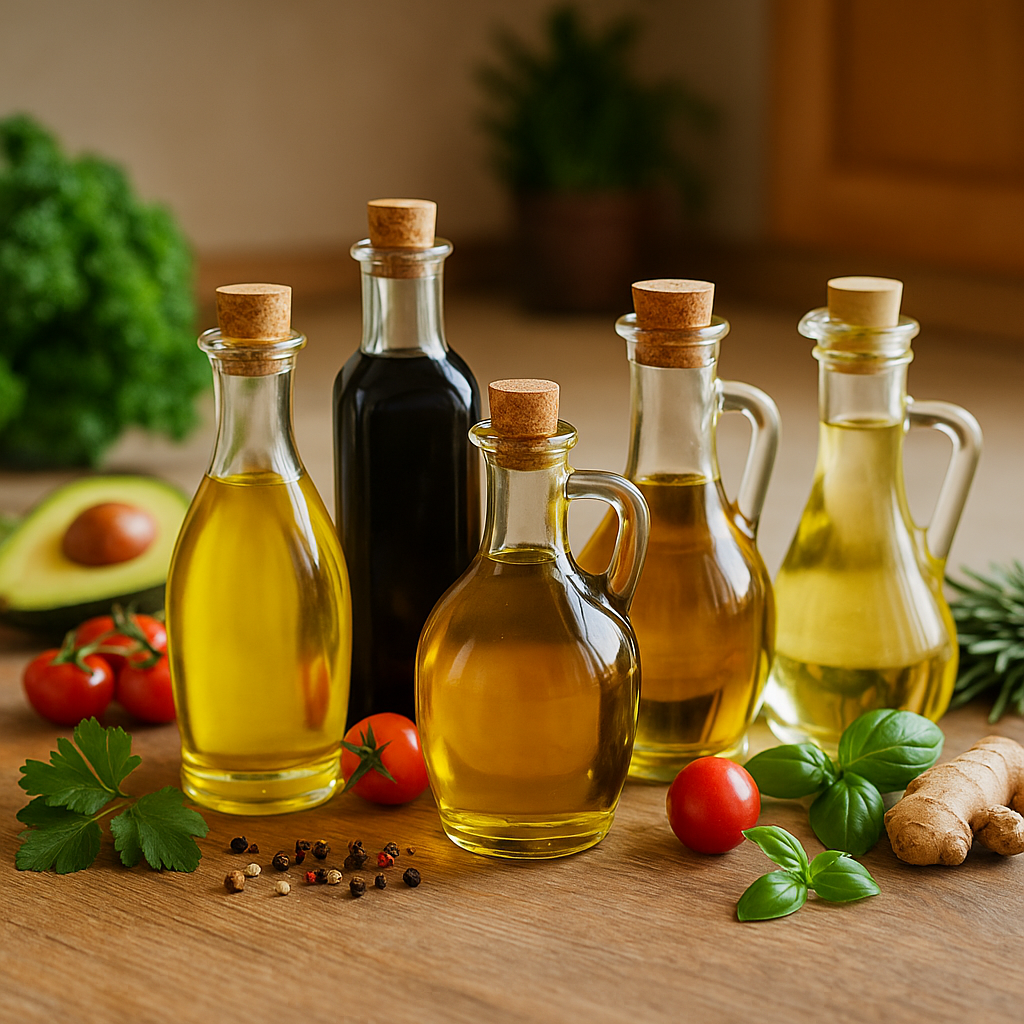Introduction
When it comes to preparing everyday meals, choosing the best cooking oil in India can make a huge difference in taste, nutrition, and overall health. With countless options on the market, it’s essential to understand which oils are suitable for various cooking methods and health goals. In this blog, we’ll explore the top cooking oils used in Indian households, their benefits, smoke points, and best uses — so you can make an informed choice.
Why Cooking Oil Matters for Your Health
Cooking oil isn’t just a medium for frying or sautéing — it’s an integral part of your diet. The best cooking oil in India should support heart health, digestion, and overall well-being. A good oil should have:
- A high smoke point for heat stability
- Balanced Omega-3 and Omega-6 fatty acids
- Low saturated fats and zero trans fats
- Rich in antioxidants and vitamins
Let’s dive into the healthiest options available in India.
1. Cold-Pressed Groundnut Oil
Why It’s Great: High in monounsaturated fats and Vitamin E.
Best For: Deep frying, sautéing, and Indian gravies.
Smoke Point: 160–180°C
Nutrition (per 100 ml):
- Calories: 884
- Fat: 100g (17g saturated, 46g monounsaturated)
- Vitamin E: 11.2 mg
Tip: Opt for cold-pressed, unrefined groundnut oil to preserve its natural antioxidants.
2. Desi Ghee (Clarified Butter)
Why It’s Great: Loaded with butyrate, a short-chain fatty acid that improves digestion and boosts immunity.
Best For: Tadka, rotis, Ayurvedic cooking.
Smoke Point: 250°C
Nutrition (per 100 ml):
- Calories: 900
- Saturated fat: 62g
- Vitamin A: 3069 IU
Recipe Idea: Add a spoonful of ghee on hot khichdi or paratha for a nostalgic, nourishing touch.
3. Mustard Oil
Why It’s Great: Rich in Omega-3, anti-inflammatory, and has antibacterial properties.
Best For: Pickles, North Indian cooking, stir-fries.
Smoke Point: 250°C (when the smoking point is reached properly)
Nutrition (per 100 ml):
- Calories: 884
- Saturated fat: 12g
- Monounsaturated fat: 60g
- Omega-3: 6g
Note: Always use Kachi Ghani (cold-pressed) mustard oil for authenticity.

4. Virgin Coconut Oil
Why It’s Great: Medium-chain triglycerides (MCTs) help with fat metabolism and cognitive health.
Best For: South Indian dishes, sautéing, baking, and even smoothies.
Smoke Point: 177°C
Nutrition (per 100 ml):
- Calories: 862
- Saturated fat: 86g
Pro Tip: Add 1 tsp to your morning coffee for an energy boost (Keto lovers, rejoice!).
5. Sunflower Oil (Cold-Pressed)
Why It’s Great: High in Vitamin E and low in saturated fats.
Best For: Deep frying, baking, and general Indian cooking.
Smoke Point: 232°C
Nutrition (per 100 ml):
- Calories: 884
- Fat: 100g (mostly polyunsaturated)
Caution: Overuse may disrupt Omega-3:Omega-6 balance — rotate with other oils.
6. Rice Bran Oil
Why It’s Great: Contains oryzanol — known to lower cholesterol and improve heart health.
Best For: Stir-frying, grilling, deep-frying.
Smoke Point: 254°C
Nutrition (per 100 ml):
- Calories: 900
- Monounsaturated fat: 47g
- Polyunsaturated fat: 33g
Health Tip: Great for people with hypertension and cholesterol issues.
Tips on Choosing the Right Cooking Oil
- Cold-Pressed: Always pick cold-pressed or wood-pressed (Lakdi Ghani) over refined.
- Rotate Oils: Don’t stick to just one. Use a variety depending on the dish.
- Check Labels: Avoid refined oils with additives and chemicals.
- Go Local: Regionally popular oils are often best suited to the climate and cuisine.

Conclusion
Choosing the best cooking oil in India isn’t just about flavor—it’s a decision that affects your heart, hormones, and health in the long run. With so many options like mustard, ghee, coconut, and sunflower oil, you can tailor your oil to suit your dietary goals and cooking style. Use the right oil for the right dish and rotate them regularly for maximum health benefits. Start today, and make your meals a blend of taste and wellness!
For more health-centric content, check out our blog on Healthy Meal Ideas Under 30 Minutes or 10 Effective Ways to Reduce Belly Fat and Improve Your Wellness.
Also, explore this in-depth guide on healthy cooking oils from this blog expand your healthy cooking oil choices.




This article provides a great insight into the healthiest food choices in India, highlighting the importance of nutritious and balanced diets. It’s interesting to see how traditional Indian cuisine aligns with modern health trends. The focus on locally sourced ingredients emphasizes sustainability and wellness. Exploring these options can inspire healthier eating habits. How can one incorporate these choices into a busy lifestyle?
Thanks for sharing your thoughts! I agree—it’s great to see how traditional Indian foods fit into a healthy lifestyle. Even with a busy schedule, simple steps like meal prepping, choosing quick recipes, or keeping healthy snacks handy can make eating well much easier. Small changes, like picking whole grains and adding more veggies, really add up over time. It’s all about finding what works best for you!
Thank you for the great question! I balance traditional Indian meals with a busy routine by planning simple, wholesome dishes that don’t take much time — like dal, stir-fried veggies, or khichdi. I also prep ingredients in advance, use time-saving tools like pressure cookers, and focus on balanced portions with whole grains, lentils, and lots of veggies to keep meals both healthy and quick.
Incorporating healthy eating into a busy lifestyle is definitely manageable with a bit of planning. Meal prepping and quick recipes can save time while ensuring nutritious meals. Keeping healthy snacks on hand prevents unhealthy choices during hectic days. Making small changes, like choosing whole grains and adding more vegetables, can make a big difference over time. How do you balance traditional Indian meals with a fast-paced routine?
Really interesting read! Seeing platforms like rr888 legit focus on data analysis for players is a smart move. Makes the casino experience more engaging, beyond just slots & live games! 👍
Solid article! Thinking about high-stakes play, security & smooth withdrawals are key – sounds like the me777 slot platform prioritizes that VIP experience. Definitely a curated approach!
Interesting analysis! It’s true that statistically diverse options can really enhance the gaming experience. I’ve been checking out money88 slot games – their focus on high RTP is a smart move for players. Solid platform overall!
Solid article! Thinking about bankroll management & variance is key in tournaments. Seeing platforms like panaloko slot offer diverse games is cool, but responsible play always comes first. Great points on adapting to different stack sizes!
Pingback: 7 Nutrition Myth: Unveiling the Truth Behind Them
I’ll immediately grab your rss as I can’t find your email subscription link or e-newsletter service. Do you’ve any? Kindly let me know so that I could subscribe. Thanks.
This article is a great reminder of how traditional Indian cuisine can align with modern health trends. I love the focus on locally sourced ingredients—it’s such an eco-friendly and sustainable approach. The idea of meal prepping and using quick recipes is brilliant for busy lifestyles. But I wonder, how do you deal with cravings for less healthy options when you’re stressed or tired? Have you found any specific strategies that work well? Also, do you think incorporating traditional Indian spices like turmeric or cumin makes a noticeable difference in health? I’d love to hear your personal experiences with this. By the way, we’ve integrated libersave into our regional coupon system. It’s amazing how easy it is to combine different providers on one platform! Whith regards, UNDER
This article really highlights the beauty of traditional Indian cuisine and its alignment with modern health trends. It’s fascinating how locally sourced ingredients can promote both sustainability and wellness. I’ve always wondered how to make these healthy choices fit into a busy schedule without compromising on taste or nutrition. Meal prepping and simple recipes seem like great solutions, but how do you avoid the monotony of eating the same dishes repeatedly? I’d love to hear some creative variations or ideas to keep things exciting!
Also, have you noticed how traditional Indian meals naturally include a balance of nutrients? It feels like our ancestors knew something we’re rediscovering today. What’s your go-to quick and healthy Indian dish that never fails to satisfy?
By the way, we’ve integrated **libersave** into our regional voucher system. It’s amazing how easy it is to combine various providers on a single platform. Have you tried it yet? It’s a game-changer for streamlining offers and savings! Whith regards, BDMGG